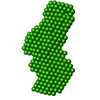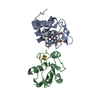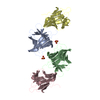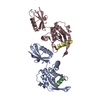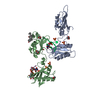[English] 日本語
 Yorodumi
Yorodumi- SASDAP5: Native complex CytC_Adr (Cytochrome C dimer, Cyt_C_dimer + Adreno... -
+ Open data
Open data
- Basic information
Basic information
| Entry | Database: SASBDB / ID: SASDAP5 |
|---|---|
 Sample Sample | Native complex CytC_Adr
|
| Biological species |  |
 Citation Citation |  Journal: J Am Chem Soc / Year: 2008 Journal: J Am Chem Soc / Year: 2008Title: Dynamics in a pure encounter complex of two proteins studied by solution scattering and paramagnetic NMR spectroscopy. Authors: Xingfu Xu / Wolfgang Reinle / Frank Hannemann / Peter V Konarev / Dmitri I Svergun / Rita Bernhardt / Marcellus Ubbink /  Abstract: In the general view of protein-complex formation, a transient and dynamic encounter complex proceeds to form a more stable, well-defined, and active form. In weak protein complexes, however, the ...In the general view of protein-complex formation, a transient and dynamic encounter complex proceeds to form a more stable, well-defined, and active form. In weak protein complexes, however, the encounter state can represent a significant population of the complex. The redox proteins adrenodoxin (Adx) and cytochrome c (C c) associate to form such a weak and short-lived complex, which is nevertheless active in electron transfer. To study the conformational freedom within the protein complex, the native complex has been compared to a cross-linked counterpart by using solution scattering and NMR spectroscopy. Oligomerization behavior of the native complex in solution revealed by small-angle X-ray scattering indicates a stochastic nature of complex formation. For the cross-linked complex, interprotein paramagnetic effects are observed, whereas for the native complex, extensive averaging occurs, consistent with multiple orientations of the proteins within the complex. Simulations show that C c samples about half of the surface area of adrenodoxin. It is concluded that the complex of Adx/C c is entirely dynamic and can be considered as a pure encounter complex. |
 Contact author Contact author |
|
- Structure visualization
Structure visualization
| Structure viewer | Molecule:  Molmil Molmil Jmol/JSmol Jmol/JSmol |
|---|
- Downloads & links
Downloads & links
-Models
| Model #133 |  Type: dummy / Software: Dammin / Radius of dummy atoms: 1.90 A / Chi-square value: 24.000201  Search similar-shape structures of this assembly by Omokage search (details) Search similar-shape structures of this assembly by Omokage search (details) |
|---|---|
| Model #134 |  Type: mix / Software: Sasref / Radius of dummy atoms: 1.90 A / Chi-square value: 3.8809  Search similar-shape structures of this assembly by Omokage search (details) Search similar-shape structures of this assembly by Omokage search (details) |
- Sample
Sample
 Sample Sample | Name: Native complex CytC_Adr / Sample MW: 44 kDa / Specimen concentration: 2.40-24.00 / Entity id: 110 / 111 |
|---|---|
| Buffer | Name: HEPES / Concentration: 20.00 mM / pH: 7.4 / Composition: DTT 2.000 mM |
| Entity #110 | Name: Cyt_C_dimer / Type: protein / Description: Cytochrome C dimer / Formula weight: 11 / Num. of mol.: 2 / Source: Escherichia coli Sequence: TEFKAGSAKK GATLFKTRCL QCHTVEKGGP HKVGPNLHGI FGRHSGQAEG YSYTDANIKK NVLWDENNMS EYLTNPKKYI PGTKMAFGGL KKEKDRNDLI TYLKKATE |
| Entity #111 | Name: Adrenodoxin dimer / Type: protein / Description: Adrenodoxin dimer / Formula weight: 11 / Num. of mol.: 2 / Source: Escherichia coli Sequence: KITVHFINRD GETLTTKGKI GDSLLDVVVQ NNLDIDGFGA CEGTLACSTC HLIFEQHIFE KLEEAITDEE NDMLDLAYGL TDDRSRLGCQ ICLTKAMDNM TVRVP |
-Experimental information
| Beam | Instrument name:  DORIS III X33 DORIS III X33  / City: Hamburg / 国: Germany / City: Hamburg / 国: Germany  / Type of source: X-ray synchrotron / Type of source: X-ray synchrotron | |||||||||||||||||||||
|---|---|---|---|---|---|---|---|---|---|---|---|---|---|---|---|---|---|---|---|---|---|---|
| Detector | Name: MAR 345 Image Plate | |||||||||||||||||||||
| Scan |
| |||||||||||||||||||||
| Distance distribution function P(R) |
| |||||||||||||||||||||
| Result |
|
 Movie
Movie Controller
Controller

 SASDAP5
SASDAP5